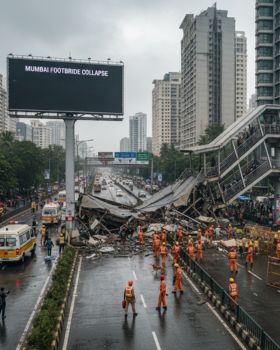
Disclaimer
Information about the 2019 Mumbai footbridge collapse is derived from publicly available news and investigation reports. This article is intended for educational and industry awareness purposes only.
In March 2019, tragedy struck Mumbai when a pedestrian footbridge near Chhatrapati Shivaji Maharaj Terminus collapsed, claiming several lives and injuring many others. The incident highlighted concerns around safety management, contractor oversight, and maintenance accountability.. What made the event particularly alarming was that According to public reports, the collapse was associated with or reportedly involved maintenance delays and communication gaps between multiple stakeholders. It revealed how fragile safety systems become when documentation, inspection, and follow-up are treated as formalities rather than integral safety practices.
Understanding the Root Cause: Gaps in Accountability
Media and investigation reports following the Mumbai bridge collapse indicated that earlier assessments had highlighted maintenance needs, though documentation and repair timelines were unclear.. Coordination challenges between various parties involved in inspection and maintenance reportedly led to documentation gaps and uncertainty over responsibilities.
This was viewed by many observers as not only an infrastructure failure but also a broader issue of accountability within complex contractor ecosystems. When multiple parties are involved in inspection, maintenance, and certification, responsibility often becomes diluted unless there is a transparent, centralized system that records and tracks every step. That’s where technology-driven safety management frameworks and contractor management solutions can play a transformative role in modern infrastructure oversight.
The Importance of Contractor Oversight
Every project, whether a small facility repair or a major public infrastructure development, relies heavily on contractors and subcontractors. They bring specialized expertise, but they also introduce new risks—ranging from non-compliance and incomplete documentation to delayed reporting. Without an organized contractor management platform, these risks multiply.
Contractors must be continuously evaluated not only for their technical competence but also for their adherence to safety standards, inspection schedules, and documentation protocols. The Mumbai incident serves as a reminder of the importance of consistent oversight in complex projects. If regular inspections, digital documentation, and accountability logs had been maintained through a unified contractor portal, many of these warning signs could have been addressed before disaster struck.
Visibility and Traceability: The Backbone of Safety
A strong safety culture depends on visibility and traceability. Organizations must know exactly who performed which inspection, when the last maintenance was conducted, and whether identified issues were closed in time. Without this traceability, follow-ups get delayed, and critical tasks are often left incomplete.
A centralized contractor management solution ensures that all this information is stored in one accessible system. It allows project owners, safety officers, and auditors to monitor activities in real-time. Automated notifications for inspections, renewals, and follow-ups could help prevent lapses that often go unnoticed in manual systems. Such visibility also builds accountability—no report or inspection can go missing, and no safety measure remains unchecked.
How Digital Systems Could Help Prevent Oversight Failures
Digital transformation in contractor management isn’t about replacing people—it’s about empowering them with accurate data and timely insights. Using a unified contractor management platform, organizations can monitor compliance, assign responsibilities, and document every safety-related activity with precision.
For example, if a bridge inspection report flags a potential issue, the system can automatically generate a corrective action, assign it to the responsible contractor, and track its completion. Real-time alerts could help ensure that no critical task remains pending. Furthermore, analytics and dashboards can reveal recurring issues, helping safety teams make data-driven decisions that prevent long-term structural risks.
These systems not only enhance compliance but also create a proactive safety culture where everyone—contractors, engineers, and supervisors—has clarity over their roles and responsibilities.
Building a Culture of Prevention Through Technology
The Mumbai footbridge tragedy has been widely seen as underscoring how reactive approaches to safety are no longer sufficient. By the time a failure becomes visible, it’s often too late. The future of safety management lies in prevention, not reaction.
A comprehensive contractor portal plays a key role in building this culture of prevention. It centralizes all contractor data, including credentials, inspection reports, training records, and safety audits. When used effectively, it gives project owners complete visibility into contractor performance and compliance history. This level of transparency could help identify weak points early and mitigate risks before they escalate.
How the Best Contractor Management Software Enhances Safety
The best contractor management software doesn’t just store data—it connects people, processes, and performance across the entire project lifecycle. It allows safety officers to create standardized workflows for inspections, permit approvals, and training verifications. With integrated reporting tools, it becomes easier to identify trends and recurring safety violations, helping organizations take immediate corrective action.
Moreover, modern systems integrate seamlessly with other safety management modules, including work permits, audits, and risk assessments. This interconnected approach ensures that contractor safety is not handled in isolation but becomes part of a larger, data-driven safety ecosystem.
Compliance and Continuous Improvement
The most valuable lesson from the 2019 incident is that compliance alone is not enough. Safety should be a continuous, organization-wide commitment built on collaboration, communication, and control. Digital contractor management tools bring structure to this commitment by creating a single source of truth—where every action, report, and responsibility is recorded and monitored.
With an integrated digital framework, organizations can move from reactive compliance to proactive safety management. Such systems ensure that inspections are timely, documentation is complete, and accountability is clear at every level. When used effectively, contractor management technology could help organizations not only meet regulatory requirements but also protect lives and infrastructure.
Transforming Contractor Management for a Safer Future
Events like the Mumbai footbridge collapse underscore the importance of maintaining strong oversight and transparent safety systems. But they also push industries toward innovation—toward systems that can help prevent such tragedies from recurring.
Implementing a robust contractor management solution or adopting the best contractor management software can bring about a cultural shift in how organizations manage risk, compliance, and accountability. When every inspection, maintenance record, and safety permit is digitally managed, the margin for error reduces significantly.
Safety is not just about structures; it’s about systems that ensure people do the right thing at the right time. And that’s where technology could help bridge the gap between compliance and true prevention.
Experience how the mai™ integrated suite could help transform your workplace safety processes. Book a personalized demonstration today.
📞 Contact Us:
USA: +1 (941) 337-167
Ireland: (+353) 21 4536034
UK: (+44) 800 8021092
🚀 Learn how SHEQ Network can support safer workflows!
📧 info@sheqnetwork.com
🔗 Learn more at sheqnetwork.com



